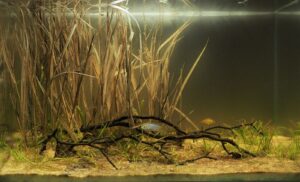Parana River, Flood Savanna Habitat, Corrientes-Argentina
_st place in Biotope Aquarium Design Contest 2022

Volume of your aquarium: 56 l
Dimensions of your aquarium: 50x35x32 cm
List of fishes: Apistogramma borelli
List of plants: Helanthium tenellum
Description of Decorations and Substrate: Long dried meadows and fine sand were designed to resemble those in nature. There are a few dried leaves on the ground and dry branches coming in waves.
Description of Equipment: Waterfall filter 240 h/liters, jbl heather 50 W, floodlight 6500 K-10 W.
Water Parameters: 24 °C , 6 gH, 4 kH, 125 ppm, 0-10 mg NO3.
Additional Info: The filter contains Seachem denitrate; very low nitrate is formed with the height of sand at the bottom. Since the water quality is good, I do 10-15% water changes every two weeks. I feed them with good quality dry food and live food.
Aquarium video:
Description of the Area Surrounding the Biotope: The Paraná River originates in central South America, from the southeastern plateau of Brazil, joins the Uruguay River and empties into the Atlantic Ocean through the Rio de la Plata Estuary. It is the longest river on the continent after the Amazon.
The length of the river is 4,880 km, its basin is 2.582,672 km², and the annual average flow is 17,290 m³/s. The catchment covers most of southeastern Brazil, Paraguay, Bolivia and Argentina.
It takes the name Upper Parana from its source to the junction with the Uruguay River. It is formed by the union of the Upper Parana Grand and Paranaíba tributaries. Flowing south, it receives the Tiete, Paranapanema and Iguaçu rivers on the right. After taking the Iguazu River, it forms the Brazil-Paraguay border and later the Argentina-Paraguay border.
The Iguazu River separates the Argentina-Brazil-Paraguay countries from each other in the area where it joins with Parana[1]. Before merging with the Parana River, it forms the Iguazú Falls.
Description of the Underwater Landscape of the Biotope: In the rainy season, rising waters cover the Corrientes savannas. The ground is covered with flooded meadows and dry grass. It forms a brown soil or white fine sand substrate. The water is clean and clear. In times of flood, dry leaves and dry branches are carried to the ponds with the floods.
Description of the Habitat Parameters: The waters in the region are clean and transparent. Winter is 16-18 °C, summer is 22-27 °C and is cool. The pH varies between 6.0-7.4 throughout the year. The waters are moderate; 50-200ppm.
List of Fishes and Invertebrates Occurring in the Nature Biotope: Apistogramma commbrae, Apistogramma borelli, Bujurquina vittata, Apistogramma trifaciasta, Cichlasoma dimerus, Australoheros facetus, Crenicichla lepidota, Crenicichla vittata, Gymnogeophagus meridionalis, Aphyocharax anisitsi, Aphyocharax rathbuni, Laetacara dorsigera, Corydoras paleatus, Otocinclus arnoldi, Palaemon argentinus.
List of Plants Found in the Nature Biotope: Echinodorus grandiflorus, Eichhornia sp., Juncus sp., Eleocharis sp., Gymnocoronis spilanthoides, Myriophyllum aquaticum, limnobium laevigatum, Pistia stratiotes, Ceratophyllum demersum, Echinodorus argentinensis, Helianthum tenellum.
Threats to the Ecology of the Biotope: Currently, the Paraná River ecosystem suffers from harmful effects triggered by indiscriminately exploitative human activities. Construction projects that build dams and other artificial barriers along the Paraná River have done irreparable damage to the river’s ecosystems. During the construction of the Itaipu Hydroelectric Dam in Paraná in 1979, the Guairá Falls completely drowned in the process of creating the dam. Such dams and waterways have also affected the aquatic and terrestrial habitats of native flora and fauna, as they endanger the migration routes of fish and even displace thousands of local people. Rapid deforestation along the riverbanks for agricultural expansion has contributed to the erosion of the land. as a result, large amounts of eroded sediment and debris are loaded into the river and the quality of Paraná’s water resources is degraded. About 88% of the original area of the Atlantic Forest around the Paraná River has been lost, compromising the existence of much of the region’s native flora and fauna. A scientific report claims that around 50% of fish species in Paraná are devastated in just 20 years. An important species of the Paraná River ecosystem and an important link in the food chain, Sábalo is also weakened by exploitative fishing. Unfortunately, these fishermen do not realize that with their irresponsible practices, they are not only seriously damaging the ecosystem.
Sources of Information:
https://www.apistogramma.com/forum/threads/borelli-from-natural-biotope-argentine-corrientes.14700/
https://tr.wikipedia.org/wiki/Paran%C3%A1_Nehri
https://www.researchgate.net/publication/288937320_Aquatic_plants_of_the_Parana_system
https://www.worldatlas.com/articles/where-does-the-parana-river-flow.html
Name: Arif Hikmet Başeğmez
Country: Türkiye
Place: Sivas
Email: arif.hb@hotmail.com
Mailing Address: Mehmet Akif Ersoy Mahallesi, 32. Sokak, 12/2, 4 Eylül Apartmanı A blok kat:7 No: 13 – Sivas, Merkez/ Türkiye
How did you know about our contest?: Facebook, youtube and instagram
